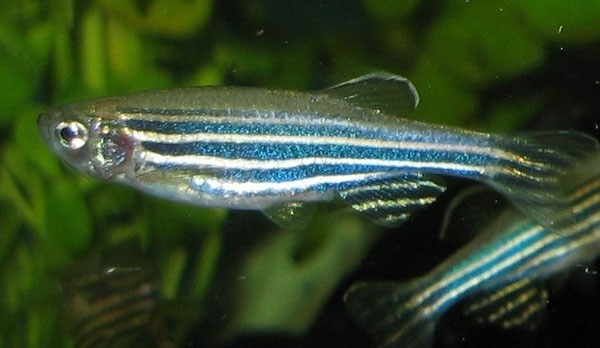Some animals can regrow their body parts when they break
From an early age, everyone would have heard or found the phenomenon of 'tail-breaking geckos' on their own. It is an extremely interesting feature in this animal: recreating the tail and leaving them when needed.
>>>Rare fish species have the ability to self-regenerate their legs
>>> Discovering the principle of regenerating the body of salamanders
But geckos are not the only species with this 'supernatural' ability. Many animals can not only develop their lost legs, tails, and even recreate their heads.
Let's take a look at some of the early regenerating masters, growing their tails below.
1. Zebra fish
With the scientific name Danio rerio, zebrafish is not only a small freshwater fish, a popular ornamental fish, but also a model of regenerating organisms with an important backbone in scientific research.
The zebrafish has a special ability to reconstruct the tail or fin that has been lost due to attack or impact by external factors.

The fish that are easy to find in these ornamental fish-selling places seem to be simple but offer amazing self-replicating abilities.
A special feature is that the fish tail is made up of many different types of cells, arranged in an extremely complex structure. They are like the fish's hands or feet.
After many studies, the researchers discovered that, after losing the tail, the fish's body produces an enzyme that converts cells into active, reproducible and variable states. Outrageous stem cells.
In 2012, Australian scientists published a study that revealed that zebrafish used a special protein, called fibroblast growth factor.

Zebrafish is also known for its ability to regenerate skin and heart.
This protein ensures that their spine can heal without leaving the nerve endings after injury.
2. Lizard
The most famous among the self-replicating animals is probably the lizard. Many lizards have the outstanding ability to shed their tail when in danger and regrow it after only a short period of time.

Unlike some salamanders or fish that are also capable of regeneration, lizards carry out this process in a different way.
The reproductive tissue is distributed throughout the body - in the muscles, cartilage, spinal cord and skin in the tail section. This helps the tail of the fish grow back perfectly while other animals focus on the tip of the tail.

By studying the tail during regeneration, the scientists identified 326 genes that were activated to replicate.
With studies of lizard tail regeneration, experts found that most of these genes exist in the human body. Therefore, they hope that in the future we will find a way to recreate the parts for ourselves.
3. Flatworms
American scientists have discovered the amazing creature - flatworm with the ability to reconstruct the head and turn into two separate individuals when "broken head".

The interesting thing is that the deeper we investigate, the more researchers discover many surprises about the self-replicating process in this seemingly simple animal.
In 2011, MIT researchers implanted a special cell into the unfortunate worm that lost his head and died. But with the ability to self-replicate, this worm lived up only thanks to a single adult cell.

Not only that, this worm can completely restore memory after losing its head. Researchers believe that the memory of worms can be stored not in the brain, but in cells distributed throughout the body. When the worm's head grows, memory recovers as never before.
4. Snail feathers
With a pompous appearance, the jellyfish's cousin also has a hobby of parasitic life on the backs of lizard snails. Therefore, they are given the friendly name of snail feathers.

Snail feathers are parasitic on the back of the snail
At first glance, many people will mistakenly believe that snail is a plant more than an animal. However, this individual is a master animal in self-replication with the ability to regrow any lost body, not biologically aging and can replicate itself.
The fur (Hydractinia echinata) is considered an extraordinary animal with immortality. Accordingly, if this creature is lost in the first part, a few days later, the new head will regrow as usual.
Experts explain that this rejuvenating power is actually due to some of the animal's stem cells are always in embryonic state throughout life.

Known as 'versatile' stem cells , the developmental ability of snail cells is not fixed, ie it can transform into a multitude of different cell types instead of lost cells. .
With research based on the self-replication of this animal, humans desire to unlock immortal secrets for themselves.
The title has been changed.
- Amazing discovery of the human body
- 5 body parts need to be kept warm in the cold season
- Startled with 5 parts of the body still dirty than the toilet
- Science says that 14 parts of the body will reveal your intelligence
- Which part of the human body is 'useless'?
- The 'witch' in the animal world
- Strange mysteries about 10 human body parts
- No body parts are okay
- Difficult person to have a cold nose?
- 10 unexpected body parts also have cancer
- Biological ink breakthrough 'in' human body parts
- 20 great things about the human body
 Animal 'suffering' after hibernation
Animal 'suffering' after hibernation Why do goats climb well?
Why do goats climb well? Scientists were surprised to see chimpanzees eating turtles
Scientists were surprised to see chimpanzees eating turtles Giant catfish died deadly due to drought in Thailand
Giant catfish died deadly due to drought in Thailand